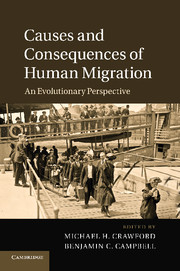Book contents
- Frontmatter
- Contents
- Contributors
- Preface
- 1 Perspectives on human migration: introduction
- Section 1 Theory
- Section 2 Geography and migration
- 8 Population structure and migration in Africa: correlations between archaeological, linguistic, and genetic data
- 9 Human migrations in North Africa
- 10 Identity, voice, community: new African immigrants to Kansas
- 11 The African colonial migration into Mexico: history and biological consequences
- 12 Demic expansion or cultural diffusion: migration and Basque origins
- 13 Consequences of migration among the Roma: immunoglobulin markers as a tool in investigating population relationships
- 14 Migration, assimilation, and admixture: genes of a Scot?
- 15 Mennonite migrations: genetic and demographic consequences
- 16 Human migratory history: through the looking-glass of genetic geography of Mycobacterium tuberculosis
- 17 Peopling the Tibetan plateau: migrants, genes, and genetic adaptations
- 18 Migration, globalization, instability, and Chinese in Peru
- 19 The great blue highway: human migration in the Pacific
- 20 Migration of pre-Hispanic and contemporary human Mexican populations
- 21 A review of the Tupi expansion in the Amazon
- 22 Molecular consequences of migration and urbanization in Peruvian Amazonia
- 23 Migration in Afro-Brazilian rural communities: crossing historical, demographic, and genetic data
- 24 Indentured migration, gene flow, and the formation of the Indo-Costa Rican population
- 25 Causes and consequences of migration to the Caribbean Islands and Central America: an evolutionary success story
- Section 3 Overview
- Index
- References
25 - Causes and consequences of migration to the Caribbean Islands and Central America: an evolutionary success story
Published online by Cambridge University Press: 05 December 2012
- Frontmatter
- Contents
- Contributors
- Preface
- 1 Perspectives on human migration: introduction
- Section 1 Theory
- Section 2 Geography and migration
- 8 Population structure and migration in Africa: correlations between archaeological, linguistic, and genetic data
- 9 Human migrations in North Africa
- 10 Identity, voice, community: new African immigrants to Kansas
- 11 The African colonial migration into Mexico: history and biological consequences
- 12 Demic expansion or cultural diffusion: migration and Basque origins
- 13 Consequences of migration among the Roma: immunoglobulin markers as a tool in investigating population relationships
- 14 Migration, assimilation, and admixture: genes of a Scot?
- 15 Mennonite migrations: genetic and demographic consequences
- 16 Human migratory history: through the looking-glass of genetic geography of Mycobacterium tuberculosis
- 17 Peopling the Tibetan plateau: migrants, genes, and genetic adaptations
- 18 Migration, globalization, instability, and Chinese in Peru
- 19 The great blue highway: human migration in the Pacific
- 20 Migration of pre-Hispanic and contemporary human Mexican populations
- 21 A review of the Tupi expansion in the Amazon
- 22 Molecular consequences of migration and urbanization in Peruvian Amazonia
- 23 Migration in Afro-Brazilian rural communities: crossing historical, demographic, and genetic data
- 24 Indentured migration, gene flow, and the formation of the Indo-Costa Rican population
- 25 Causes and consequences of migration to the Caribbean Islands and Central America: an evolutionary success story
- Section 3 Overview
- Index
- References
Summary
Introduction
The Caribbean Islands of the Lesser Antilles were originally settled by Native American Arawak populations approximately AD 100 (Haag, 1965). From the 1200s, until the time of European contact, Carib Indians began to diffuse into the Lesser Antilles from Venezuela replacing or intermixing with the original Arawak population (Rouse, 1976; Taylor, 1977). Africans began arriving in the Americas during the time of the trans-Atlantic slave trade between the fifteenth and nineteenth centuries. This forced migration over vast geographic distances dramatically changed the genetic landscape of the Caribbean.
Colonialism and its impact in the Caribbean
In the late fifteenth century Spain entered the Caribbean as the first European country with colonizing intent. As the Spanish expanded into neighboring Caribbean islands from their original settlement on Hispaniola (today’s Dominican Republic and Haiti), imperialist views resulted in enslavement of the native populations along with the Africans who had arrived along with the Spanish explorers and colonists. Realizing that more labor force was needed for economic exploitation, Spanish King Charles V, in 1518, sanctioned the direct shipment of Africans to the Caribbean, thus beginning the trans-Atlantic slave trade. By the seventeenth century, French, Dutch, and English influences had begun intruding into the Spanish-American world of the Caribbean (Knight, 1990). Along with their imperialism, these European powers introduced a host of diseases to which the native populations of the islands had no resistance, including smallpox, typhus, and measles. Smallpox in particular decimated or extinguished entire civilizations, the knowledge of which was used at a later date in 1763 by a British military colonel with insidious purpose by suggesting that smallpox-infected blankets be given to Native Americans to precipitate an epidemic (Jobling et al., 2004; Stearn and Stearn, 1945). Malaria was introduced into the Americas by Africans who were already infected with the disease at the time of their arrival and the presence of suitable malarial vectors in the Americas sustained the disease (CDC, 2009). The combination of disease imports from both Europe and Africa, such as smallpox, malaria, yellow fever, chickenpox, whooping cough, diphtheria, plague, typhoid fever, and cholera, proved disastrous for the susceptible Native American population (Crawford, 1998).
- Type
- Chapter
- Information
- Causes and Consequences of Human MigrationAn Evolutionary Perspective, pp. 512 - 524Publisher: Cambridge University PressPrint publication year: 2012



